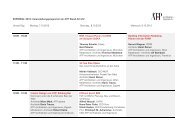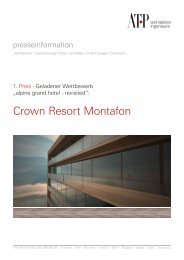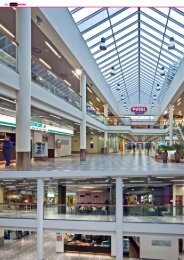alpbacher architekturgespräche 2003 - ATP
alpbacher architekturgespräche 2003 - ATP
alpbacher architekturgespräche 2003 - ATP
Sie wollen auch ein ePaper? Erhöhen Sie die Reichweite Ihrer Titel.
YUMPU macht aus Druck-PDFs automatisch weboptimierte ePaper, die Google liebt.
to provozieren. Genauso wie der Psychoanalyst - der im Gegenteil zu den Medien passiv wird, um<br />
den Patient aktiv zu machen - sind wir Architekten auch Psychoanalysten von Kopf und Körper. Im<br />
Gegensatz zu den Medien können wir, genauso wie der Psychoanalyst, den Kopf, Körper und Augen<br />
zu neuem Handeln bewegen. Deshalb ist die Architektur in der heutigen Welt eine der wichtigsten<br />
Disziplinen, und das erklärt auch warum so viele Philosophen, Sozialwissenschaftler und andere von<br />
Architektur fasziniert sind. Ich treffe überall auf Leute, die von Architektur fasziniert sind. Es gab nie<br />
ein derartiges Medieninteresse, wie wir es beim World Trade Centre Wettbewerb, an dem wir auch<br />
teilgenommen haben, erfahren haben. Vielleicht konnte man schon immer in den Zeitungen in<br />
Deutschland, Italien und Spanien über Architektur lesen, aber jetzt hat Architektur sogar unsere primitive<br />
Kultur erreicht und erscheint in der New York Times.<br />
Ich glaube, dass Architektur wieder zu einem Medium wird, das Aktivität kreiert. Ich sage den Professoren<br />
und den Architekten und insbesondere den Studenten, dass eine Revolution und ein Bruch statt<br />
gefunden hat, wovon sie alle Nutznießer sind. Meine Generation und sogar die Generation danach<br />
sind nicht in der Lage das zu verstehen, aber Sie sind die Computer-, die Medien- und die DNA-<br />
Generation. Sie verstehen es. Genauso wie man mit fünfzig nicht mehr Fußball spielen kann oder man<br />
keine schöne Musik spielen kann wenn, man erst mit fünfzig mit dem Klavierunterricht anfängt, man<br />
muss jung damit anfangen. Ich wurde zwar mit fünfzig neu geboren aber trotzdem verstehe ich nicht<br />
die Rhythmen Ihrer Musik oder die Spiele auf Ihren Computern. Ich kann nicht mit einen Computer<br />
umgehen oder eine E-Mail versenden. Mein Sohn verschickt SMSs und hält mich für einen Troglodyten.<br />
Ich bin die Botschaft von Mr. Kontinuität. Ich verkörpere die Vergangenheit, deswegen haben<br />
Sie von mir nichts zu befürchten. Ich singe das Lied der Sirenen, um Sie zu ermutigen nicht passiv zu<br />
werden. Ich verkörpere die alte Passivität, weil nichts das ich oder meine Kollegen heute machen,<br />
heute klangvoll werden kann.Wichtig ist, was Sie machen.<br />
Christoph Imboden, p. 115<br />
Living with Decreasing Resources<br />
Summary<br />
The decreasing resources<br />
Despite strongly rising environmental awareness and increased investment by<br />
government, NGOs and the private sector in the protection of nature and the<br />
environment, global biodiversity has continuously diminished over the past 30<br />
years.The Living Planet Index of the WWF (figure 1) – the Dow Jones of the natural world – shows<br />
a loss of one third in this time.<br />
The loss of biodiversity is not just a feature of the distant tropical rainforests, - with their rich range<br />
of species – but also something happening here in Europe. 38% of European bird species have shown<br />
a marked population loss in the last 25 years.These are important indicators for the overall status of<br />
biodiversity.The majority of these birds live in agricultural and wetland area and their disappearance<br />
can be directly related to more intensive land use and development.<br />
Living beyond our means<br />
This apparently unstoppable decline in the diversity of species worldwide is a sign of man’s excessive<br />
exploitation of nature.The growing need for land and other natural resources leads to a direct reduction<br />
of living space for other species.<br />
Humankind uses more natural resources today than nature produces, meaning that we live not just on<br />
the interest of nature but are also eating into the limited capital. Hence we are playing with the wellbeing<br />
of future generations, maybe putting at risk their survival. Alongside the disappearance of animal<br />
and plant species, there are also many other signs of ecological over-exploitation: the global loss of forests<br />
and related, sometimes catastrophic, land erosion, the reduction of the ozone layer in the earth’s atmosphere,<br />
the global warming due to the increasing production of greenhouse gases (in particular CO2: see<br />
figure 5), the locally catastrophic collapse of yields in marine fisheries, and many others. In order to<br />
measure man’s use of nature; the concept of the ecological footprint has been developed. Everything<br />
that man takes from nature must have been produced by nature – whether on land or in the water.<br />
Hence the ecological footprint of an individual – or of society - measures the biologically productive<br />
land and sea area that would be required to produce, using today’s technologies, all consumed energy<br />
and other resources and to absorb all the waste produced, irrespective of where, geographically, this<br />
land is situated (local, national or global). In other words, this ecological footprint gives a balance of<br />
man’s use of nature and the costs of the energy and material flows required by an economic unit.This<br />
allows us to answer such important questions as<br />
• What is our dependence on global ecosystems?<br />
• What pressure are we putting on these ecosystems in order to produce raw materials or dispose<br />
of waste?<br />
• Who requires how much of the global production of the biosphere?<br />
For the calculation of the footprint distinction is made between five different categories of consumption:<br />
food, living, transport, consumer goods and services. For the terrestrial part of the footprint one<br />
can further differentiate between various sorts of production space (forests, pastures, arable land etc).<br />
Thereby we can create a matrix linking consumption and production area required according to which,<br />
for example, each Canadian consumes the biological production of 6.6 Hectares of land per year.<br />
Similar calculations for the lifestyle of Austrians demonstrate an annual need for 5.24 hectares of land<br />
and 0.39 hectares of sea (figure 7). However when the available land of Austria is divided by the<br />
number of people living there, only 2.35 hectares are available per person.To satisfy their consumption<br />
habits, the people in the northern hemisphere require more than twice as much land to fulfil<br />
their consumer needs.The richest fifth consumes 80% of raw materials and uses 96% of the earth’s<br />
ecological capacity.The other 80% must survive on the remaining 4%. Each year man consumes the<br />
productive capacity of two earths (figure 8). Our limited natural capital is disappearing fast. Since 1960<br />
the land required for biological production has more than doubled and the majority of this has been<br />
due to increasing energy use.While for the absorption of growing amounts of CO2 we would require,<br />
for example, ever increasing areas of forest, in reality these are fast disappearing, meaning that greenhouse<br />
gases can no longer be dealt with by nature. Extrapolating into the future - a growing world<br />
population with increasing living standards (meaning an increasing ecological footprint) - brings ever<br />
more into question the theoretically widely agreed target of achieving a sustainable economy.<br />
Which sustainability?<br />
Since the Rio Earth Summit of 1992 the concept of sustainable development has become an increasingly<br />
central theme of politics, economics and the global development community. For the first time,<br />
it appeared, economists and ecologists were speaking the same language.Yet it is easy to agree on a<br />
concept when it allows a wide spectrum of definitions and interpretations. For some, the emphasis is<br />
on “sustainable”, for others on “development”. In between there is a huge grey area in which superficial<br />
agreement on terminology disguises widely differing views on the concept itself and lack of clarity<br />
208<br />
< alpbach architecture forum <strong>2003</strong>: documentation >






